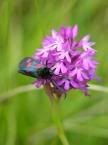

Scientific Name
Sanguisorba minor
Uses of Small Burnet: Landscaping, Medicinal, Culinary, etc...
Grazing/rangeland: Small burnet is noted to have good to excellent forage value for livestock and wildlife during all seasons. It stays green throughout the growing season and into winter until heavy snow cover occurs, providing forage and seed to livestock and wildlife. It provides excellent diversity to the seeded plant community.
Erosion control/reclamation: Small burnet is noted for value in mixes for erosion control and beautification values.
Wildlife: Small burnet is considered very desirable forage for elk, deer, antelope and birds either as herbage or seed. Birds use the seed in fall, winter and spring. It also provides cover for selected small bird species. It provides diversity to the plant community.
The leaves of small burnet can be added to salads, ice drinks, vinegar, butter, and cream cheese to add a fresh, pleasant, cucumber-like flavor.
General Characteristics
Small burnet (Sanguisorba minor Scop.) is a hardy, relatively long-lived, evergreen, introduced, perennial forb. It is usually a branched caudex (thick base of stems) with a prominent tap root and sometimes weakly rhizomatous. Small burnet plants have alternate pinnately compound leaves. Leaflets are mostly 9 to 17, oval to oblong, 4 inches long and coarsely toothed. Total height varies from 6 inches on droughty sites to approximately 25 inches on irrigated sites. The flowers are closely packed in headlike to elongate spikes 3 to 8 inches long. The flowers are mostly imperfect, the lower ones male and the upper ones female with no petals and about 12 stamens. Native burnet species have 2 to 4 stamens. The seed is an achene, oblong, about 4 to 5 mm long, woody and warty, between and along rather prominent ridges which are 4 in number.
Required Growing Conditions
Small burnet does best on well drained soils and infertile to disturbed soils. It can be planted and will establish in 12 inches or more rainfall areas, but generally does not persist below 14 inches. It has excellent cold winter and drought tolerance. It tolerates weakly saline to weakly acidic sites. Small burnet is not tolerant of poor drainage, flooding or high water tables. It is usually used in open areas, but will tolerate minor semi-shaded conditions. It is considered fire resistant due to leaves and stems staying green with relatively high moisture content during the fire season.
Small burnet is distributed primarily throughout the West and Northeast.
Cultivation and Care
Small burnet should be seeded with a drill at a depth of 1/4 to 3/4 inch into a firm seedbed or broadcast using seed dribblers or aerial applications. Small burnet is not recommended for single species seedings. The full seeding rate (not recommended) for this forb is 20 pounds Pure Live Seed (PLS) per acre or 20 PLS per square foot. When used as a component of a mix, adjust to percent of mix desired. In most cases a rate of 2 to 5 pounds per acre would be adequate in mixtures with other species. For mined lands and other harsh critical areas, double the seeding rate component of small burnet. The best seeding results are obtained from seeding in late fall to very early spring (because of grass component of mix) on heavy to medium textured soils and in late fall on medium to light textured soils. Late summer (August - mid September) seeding is not recommended unless site is irrigated. Mulching, irrigation and weed control all benefit stand establishment. Seedling vigor is excellent, but the plant establishes slowly. Germination normally occurs the first growing season if adequate moisture is available. Full flowering should not be expected until at least the second growing season.Stands may require weed control measures during establishment. Because small burnet is a broadleaf, use of 2,4-D is not recommended. Mow weeds at or prior to their bloom stage. New stands may also be damaged by grasshoppers and other insects and pesticides may be needed.
General Upkeep and Control
Growth of small burnet begins in early spring and flowers appear in late May through June. The plant establishes slowly and should not be grazed until at least the second growing season. Small burnet plants have been known to persist for more than 20 years on western rangelands. As with other species, the life of the plant can be prolonged if it is permitted to set seed on a rotational basis. Weed control and removal of very competitive species may improve establishment.
Pests and Potential Problems Damage from wildlife and rodents may occur and they may need to be controlled. Disease problems are minimal with small burnet.
Environmental Concerns Small burnet establishes and spread relatively quickly via seed distribution. It is not considered weedy or an invasive species, but can spread into adjoining vegetative communities under ideal climatic and environmental conditions. It coexists with other species and adds biodiversity to those plant communities.
Cultivars, Improved, and Selected Materials (and area of origin) 'Delar' small burnet (Sanguisorba minor Scop.) is a selected release from seed originating from European sources. The name 'Delar' denotes pleasing or alluring after the attractive green lush appearance of the plant. 'Delar' was selected by Aberdeen Plant Materials Center for outstanding seed and forage production, good cold tolerance and palatability for both livestock and wildlife. It was released in 1981 by the Natural Resources Conservation Service and the University of Idaho Agricultural Experiment Station. 'Delar' is a hardy, relatively long-lived, evergreen, non-leguminous, introduced, perennial forb from 6 inches tall on droughty sites to approximately 25 inches tall on irrigated sites. It is well adapted to sunny flatlands to open slopes, well drained soils from moderately basic to weakly acidic, 12 to 18 inch rainfall areas, at 1,000 to 6,000 feet elevation. It will easily establish at the lower rainfall zones, but may not persist below 14 inches. It is not tolerant of shade, poor drainage, flooding or high water tables. It does well seeded in mixtures with other species. Its intended uses are erosion control, reclamation, rangeland improvement, wildlife forage, and site diversity. Certified seed is readily available through commercial sources and breeder seed is maintained by Aberdeen Plant Materials Center.





0 comments: